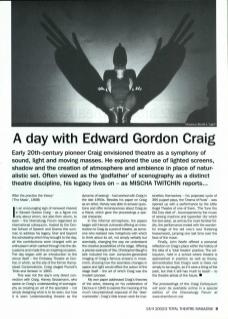‘After the practice the theory.’ ('The Mask', 1908)
In an encouraging sign of renewed interest in Edward Gordon Craig – as a figure not only about whom, but also from whom, to learn – the Dramaturgy Forum organised an international colloquium, hosted by the Central School of Speech and Drama this summer, to address his legacy. Over and beyond the scholarship which they brought to the day, all the contributions were charged with an enthusiasm which carried through into the discussions and made this an inspiring occasion. The day began with an introduction to the venue itself – the Embassy Theatre at Central, in which, as the site of the former Hampstead Conservatoire, Craig staged Purcell's Dido and Aeneas in 1900.
This was not the day's only direct connection with Craig. Harvey Grossmann, who spoke on Craig's understanding of scenography as creating an art of the spectator – not simply designing what is to be seen, but how it is seen (understanding theatre as the dynamic of seeing) – had worked with Craig in the late 1950s. Besides his paper on Craig as an artist, Harvey was able to answer questions and offer reminiscences about Craig as a friend, which gave the proceedings a special character.
In this informal atmosphere, the papers began with Henryk Jurkowski offering an introduction to Craig as a poet of theatre, as someone who realised new metaphors with which to think about its art, not simply verbally but scenically, changing the way we understand the creative possibilities of the stage. Offering a precise example of this, Christopher Baugh's talk included his own computer-generated imaging of Craig's famous screens in movement, showing how the seamless changes in space and light would effect the action of the stage itself – the art of which Craig was the modem pioneer.
My own paper addressed Craig's theories of the actor, drawing on his celebration of Decroux in 1945 to explore the meaning of his much misunderstood espousal of the ‘übermarionette'. Craig's little known work for marionettes themselves – his projected cycle of 365 puppet plays, the Drama of Fools – was opened up with a performance by the Little Angel Theatre of one of them, The Tune the Old Cow died of. Accompanied by the music of sewing machine and typewriter (for which the text asks), as well as the more familiar fiddle, the performance ended with the wonderful image of the old cow's soul fluttering heavenward, jumping one last time over the face of the moon.
Finally, John Keefe offered a personal reflection on Craig's place within the history of the idea of a total theatre practice. The colloquium, held in a school where theatre is approached in practice as well as theory, demonstrated that Craig's work is there not simply to be taught, as if it were a thing of the past, but that it still has much to teach – to the theatre artists of the future.
The proceedings of the Craig Colloquium will soon be available online in a special edition of the Dramaturgy Forum at www.dramforum.net

